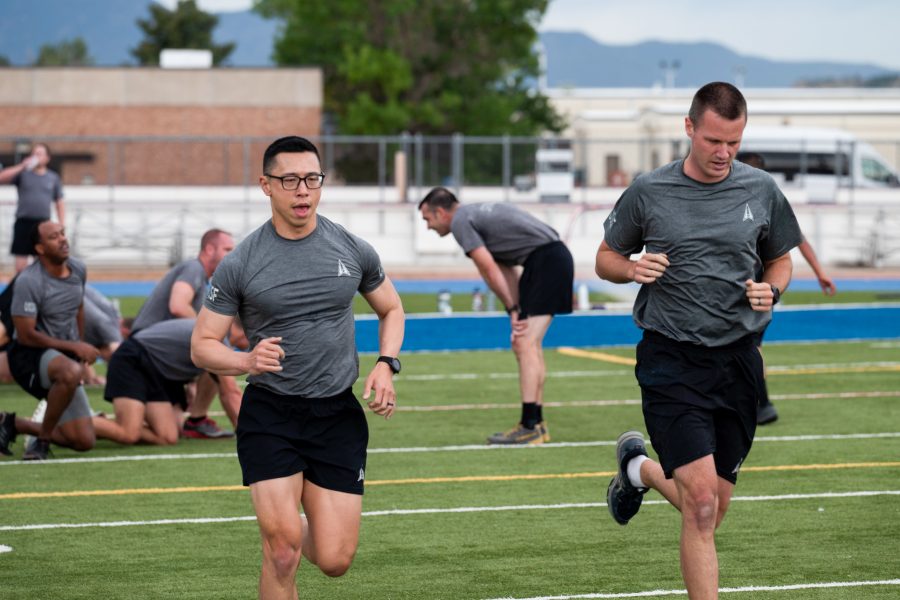The Space Force introduced its own physical fitness program, the first one ever developed just for Guardians. The new twice-annual assessment is similar to the Air Force’s new test and also extends the Space Force’s study using wearable fitness trackers.
Outlined in the new Space Force Manual 36-2905, “Human Performance and Readiness,” the new fitness program arrives just as leaders are wrapping up USSF’s “Continuous Fitness Assessment” study, which used smartwatches to track Guardians’ exercise and health.
“Interim results show that Guardians regularly exceeded the exercise requirement, suggesting excellent adoption and adherence to exercise requirements,” a service spokesperson told Air & Space Forces Magazine. The Space Force noted no documented increase in injuries as a result of increased exercise. “Guardians exhibited significant improvements in cardiorespiratory fitness after 12 months of participation in the CFA study,” the spokesperson said. “The pass rate increased to 92 percent.”
Now the Space Force is extending the study further, adding new “data-driven modifications” intended to increase monthly exercise requirements and gain faster and improved fitness outcomes.
The original test concludes Sept. 30, and the new experiment, dubbed CFA PRIME, launches Oct. 1. The new PT testing officially begins Jan. 1, 2026.
Guardians who volunteered for the initial study were exempt from PT tests for two years and those who sign on for the follow-up will have to take only one annual PT test instead of two.
Like the Air Force’s recently revamped PT test, the Space Force’s “Human Performance Assessment” test will include:
- A cardio portion with either a 2-mile run or 20-meter High Aerobic Multi-Shuttle Run, but at least one of the tests each year must include a 2-mile run.
- A muscular endurance portion including either 1 minute of sit-ups, 2 minutes of cross leg reverse crunches, or a timed forearm plank
- A muscular strength portion including either 1 minute of push-ups or 2 minutes of hand release push-ups.
One key difference: The Space Force’s body composition assessment—measured as waist-to-height ratio—is not a scored portion of its test. The Human Performance Assessment totals 80 points: 50 points for the cardio portion and 15 points each for the endurance and strength portions. Guardians who score:
- 72 points or higher are deemed “Fit to Fight.”
- Between 60 and 71.9 are rated in “Health Maintenance.”
- Below 60 are considered a “Health Concern,” and must enroll in a fitness improvement program and retest in three months.
The full scoring tables are currently only available on internal Space Force forums.
When the Space Force first stood up in 2019, it used the Air Force’s physical fitness program and test for Guardians. Within a few years, leaders began planning a different approach, driven by the service’s small size and unique mission set, which confines most Guardians to being deployed in place, working from desks.
In 2023, the Space Force unveiled its Holistic Health Approach, trying to take a more expansive approach to Guardians’ health and wellness compared to once-a-year tests. That included the Continuous Fitness Assessment, which gave service members Garmin fitness trackers and gathered data on their exercise habits. In particular, officials looked at:
- Cardiovascular intensity minutes, or time working out with an elevated high heart rate, the goal being 600 minutes per month.
- One VO2 max assessment per month
- One-minute maximum repetition pushup test per month
- Questionnaires and surveys
Around the same time as the study started, the service also unveiled “Guardian Resilience Teams,” consisting of a holistic health integrator, certified strength and conditioning specialist, licensed mental health provider, and physical therapist, to help troops take care of themselves.
The GRTs remain and will train and certify new “Unit Fitness Cells,” or teams of Guardians who will lead physical training, administer the new test, conduct body composition assessments, guide fitness improvement programs, and coordinate unit PT programs for commands.
Released Sept. 26, the new Space Force manual came out just days before Secretary of Defense Pete Hegseth told hundreds of generals and admirals at Marine Corps Base Quantico on Sept. 30 that the military needed to weed out “fat troops” from its formations.
Hegseth subsequently released a memo directing every service member to “perform physical fitness training every duty day.”
The USSF manual calls for units to conduct 60 minutes of PT at least three days a week, which would leave a few days for Guardians to work out on their own. A Space Force spokesperson said the service has not received any instructions to update its manual based on Hegseth’s direction.
Hegseth has made physical fitness and readiness a defining priority of his tenure. His latest memo directs the services to administer “Combat Field Tests” for combat arms personnel. Uniquely, however, the Space Force is exempt from that requirement, with no career fields identified on the list of combat arms occupations.


